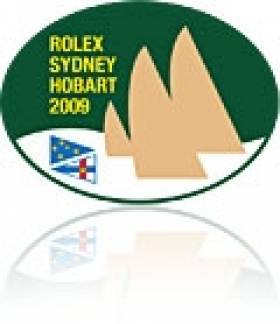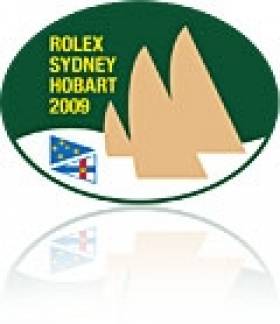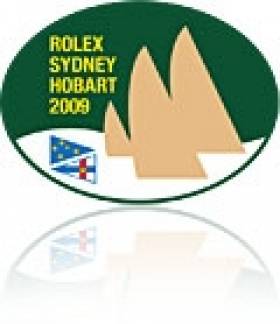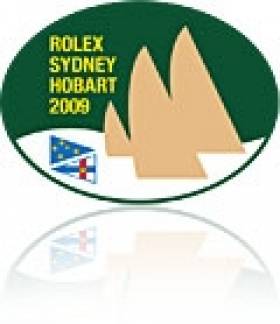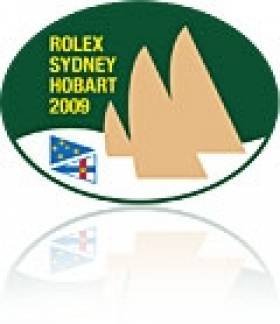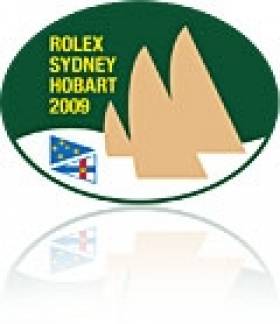Displaying items by tag: sydneyhobart
Sydney–Hobart Yacht Race Weather: Light Winds to Start Then Strengthening Quickly
#rshyr – A strong wind caution has put the Sydney to Hobart race fleet on notice but a predicted lull has increasingly-fancied American newcomer Comanche. A number of Irish sailors are among the crews competing.
A long-range weather briefing on Monday indicated the 117 yachts will begin racing in light easterly winds on Sydney harbour but should prepare for conditions to get livelier quickly.
"As the boats move out of the heads and start making their way down south, they'll encounter wind speeds of around 20 to 30 knots," said NSW Bureau of Meteorology's Andrew Treloar.
"It is likely we will have a strong wind warning."
Later in the race, however, the super-maxis are likely to be most affected by a lull as the lead boats reach Bass Strait, when winds could drop below five knots for around an hour.
Despite contesting its first big race, Comanche, the high-tech new super maxi owned by American Jim Clark and his Australian wife Kristy Hinze-Clark, is being well-backed to be first to Hobart, denying Wild Oats X1 a record eighth line honours victory.
Comanche navigator Stan Honey welcomed the forecast stiff winds early in the race but was wary of the light air expected for Saturday night.
In the vid above boatsontv.com spoke to top navigators Tom Addis of Perpetual LOYAL and Juan Vila Wild Oats XI along with Andrew Treloar of the BOM on the weather for the Race.
As the height of the festive holiday season approaches, preparations are in full swing and excitement fervent for Friday's start.
The magnitude of this 70th edition is reflected in the size of the international fleet: the forecast 117 race entrants, comprising yachts from seven different countries, represents the most sizeable Rolex Sydney Hobart depart since 1994.
"This year is both the 70th edition of the race and the 70th anniversary of the Cruising Yacht Club of Australia," explains John Cameron, Commodore of the race organisers. "There is a strong international flavour in 2014 with Maxis coming from America and lifting the level of appreciation of yachting around the world and the importance of this race. The Rolex Sydney Hobart is part of Australian culture; and for the start Sydney Harbour becomes an amphitheatre. An estimated 500,000 people will line the shoreline, together with hundreds of boats coming to watch the start on the water."
The pre-race weather briefings have provided competitors with an early idea for what to expect. Record-breaking conditions are not forecast; a gripping, intriguing, tactical adventure down to Hobart is guaranteed. Weathermen predict a strong southerly during the first day, slowing the progress of the 100-foot Maxis in their pursuit for line honours and the race record. The northerly breeze forecast, following the arrival of the frontrunners in Hobart, could benefit the mid-fleet in the pursuit of the coveted Tattersall's Cup awarded to the race's overall winner.
Wide demographic
The 2014 race's impressive and eclectic list of international competitors includes leading lights from the business world, America's Cup winners, a former supermodel, a plastic surgeon, soldiers and veterans from the Australian Defence Forces and champions from the sports of rugby and surfing. Competing yachts range from Sean Langman's 80-year old, nine metre Maluka of Kermandie, through to Southern Myth which first competed in the race in 1954, to the five 100-foot Maxis, the newest of which is Jim Clark's imperious Comanche from the United States. Foreign crews including the Polish entrants on Katharsis II and Selma Expedition have travelled thousands of nautical miles to compete in the race for a first time; contrasting to Martin Power's Bacardi set for her record twenty-ninth journey south. The race welcomes its very first competitor from South Korea, Sang Cho on Clipper Ventures 10; and witnesses Duende's Tony Cable compete in the race for a momentous 49th occasion. There are those planning days on a diet of freeze-dried food, others with a dedicated chef onboard.
Line honours quest
In the quest to be first to Hobart, Wild Oats XI, fastest finisher in seven of the last nine races, remains the crew to beat. An unprecedented eighth win would elevate Bob Oatley's crew to the record books surpassing the seven line honours victories set by Morna/Kurrewa IV between 1946 -1960.
Wild Oats XI's task is rendered more difficult, and intriguing, this year with the presence of the world's newest and most technologically sophisticated Maxi as her direct rival. Comanche arrives with great promise and potential. Clark will not be sailing south but his Comanche crew is stacked with an impressive array of professional sailing talent including skipper Ken Read and 2014 ISAF Rolex World Sailor of the Year, James Spithill. "This is sort of a Volvo 70 on steroids. It's an unusual design, pretty radical," explained Clark. "If I wanted to build a boat just for the Sydney to Hobart, I would have taken the most famous, successful boat of all time in that race and copied it. Instead, we designed a boat to be in open ocean races and try to break records. It's probably the most radical boat design in this race."
The crews of Wild Oats XI and Comanche are not expecting a simple head-to-head tussle for line honours. At 87, Australian sailing icon Syd Fischer is striving for success with his virtually rebuilt Ragamuffin 100. Fischer has already tasted line honours glory this year, winning the Rolex China Sea Race in April. Perpetual Loyal's Anthony Bell won line honours in 2011, and will seek to upset the formbook again. The Perpetual Loyal crew comprises Tom Slingsby, Spithill's America's Cup teammate and 2010 ISAF Rolex World Sailor of the Year. Manouch Moshayedi's RIO 100 makes for an interesting outsider, especially if conditions suit his boat. "We are made for lighter winds. If it is really windy Jim Clark will enjoy it, if it is really light I will!," admitted Moshayedi.
Defender of the crown
Victoire is the defending champion and seeking to make history becoming the first boat to win back-to-back Rolex Sydney Hobarts since the mid-1960s. As the early weather forecast indicates a race that could favour the mid-fleet, Darryl Hodgkinson's 50-ft boat could be among the pack primed for glory. Her winning mentality could make the difference. "In the last three Hobart's we won our division every time. We know we're getting better. We understand the sail plan better and are better prepared than last year. I'm nervous, but we're in a better place than last year," explained Hodgkinson.
The race record to beat is one day, 18 hours, 23 minutes and 12 seconds set by Wild Oats XI in 2012; requiring the first boat to arrive in Hobart on Sunday 28 December before 07:23.12 local time.
Irish Crews Among Small Boat Sailors Boosted By Sydney-Hobart Race Weather Forecast
#rshyr – In Sydney, forecasters have revealed that a southerly breeze will play in to the hands of smaller boats – including a number of Irish sailors – for Australia's 70th Rolex Sydney Hobart race that starts on St. Stephen's Day.
Irish crews competing in four days time include Sydney–based Gordon Maguire, orginally from Howth Yacht Club racing on the front–runner Carkeek 60, Ichi Ban. And as Afloat.ie previously reported, Barry Hurley of Cork Harbour and the Royal Irish Yacht Club leads a part Irish crew on the First 40 Breakthrough with Irish National Sailing School brothers Kenneth and Alexander Rumball and Dublin Bay sailor Catherine Halpin on board. Hurley, a Middle Sea Race Winner from October, gave an account of his Sydney–Hobart preparations here.
Locally based Irish sailor Keith Hegarty is racing his first Sydney-Hobart on Merlin, a Kaiko 51, owned and skippered by 81–year–old David Forbes, a legend in Australian sailing with an Olympic Gold Medal from Munich 1972.
There are estimated to be quite a number of Irish sailors competing in the race spread across the fleet.
Pam Lee, daughter of Greystones dinghy sailor Norman Lee, is racing on board Blacksheep, a Beneteau 45 rookie boat owned by Sharpie sailors Derek and Martin Sheppard from Wollongong. Lee is one of three girls on board and is sailing despite having her knee in plaster due to an unintended gybe during a night practice race in November when her leg got trapped by the mainsheet as she played the spinnaker sheet.
Read more on Irish participation in WM Nixon's blog here. Also more here from David O'Brien in last Friday's Irish Times Sailing column.
The early Christmas weather forecast gift to small yachts means the big glamour boats (including five maxis) may yet miss out on oan overall handicap win with smaller craft – roughly forty foot in length – favoured.
"We're really excited by this forecast," says Tom Barker, the navigator on the Ker 40 St George Midnight Rambler. "In terms of handicaps, the slow start means that is more time the big boats will have to take out of us.
The 117 yachts in the Rolex Sydney Hobart will face an early test this year, with the Bureau of Meteorology (BOM) forecasting a sharp 20 to 25 knot southerly change on Boxing Day afternoon not long after the start.
A southerly is expected to hold throughout the night at around 20 to 25 knots so it will be a long, wet first day for all crews.
Andrew Treloar from the BOM says winds will get lighter the further south the boats go, and the front runners should cross a high pressure ridge around Gabo Island giving them light westerlies across Bass Strait on Saturday.
Winds off the Tasmanian coast on Saturday night are also expected to be pretty light westerlies. They could be quite fluky.
"The midfield and tail end boats will get a better go from the wind," Treloar says. "They will tend to stay up around 10 to 15 knots right through as they cross Bass Strait and sail down the Tasmanian coast."
So this is a classic mid-sized to small boat forecast. A southerly on day one, stopping the super maxis from getting too far ahead, and a northerly after the glamour yachts are already tied up in Hobart.
Ireland To Sail in 70th Sydney–Hobart Yacht Race on December 26th
#rshyr – Ireland will be racing in the Rolex Sydney Hobart Yacht Race that marks its 70th edition this year, a momentous achievement for an offshore race that has become an international classic since its creation in 1945.
Ireland's Barry Hurley, who was part of a winning crew in October's Middle Sea Race is heading for the Cruising Yacht Club of Australia's Sydney Hobart Yacht Race. More details on the Irish entry in the race here.
Over the course of its proud history, the Rolex Sydney Hobart has paid homage to feats of bravery, extraordinary seamanship, speed and endeavour; has witnessed adversity and overcome tragedy; and has attracted a diverse cross-section of people to contest this nautical rite of passage. The race has been conquered by both 30-ft Corinthian-crewed boats and imperious, professionally-sailed 100-ft Maxi yachts.
Rolex has sponsored the competition since 2002, an integral part of its triumvirate of 600-nm offshore classics also comprising the United Kingdom's Rolex Fastnet Race (first run in 1925) and the Rolex Middle Sea Race (dating back to 1968). The values of adventure, courage, determination, discovery and sportsmanship set these offshore races apart from other yacht-racing events, and reflect a rigorous sporting ethos with which Rolex is privileged to be associated.
Make a race of it
The original idea of sailing from Sydney to Hobart, Tasmania, was launched by members of the Cruising Yacht Club of Australia (CYCA) shortly after its creation in 1944. Originally planned as a cruise, history recounts that John Illingworth, a British Navy officer residing in Sydney who had competed in the Fastnet in 1937, only agreed to take part if the other participants would "make a race of it", which they did. Nine yachts – ranging from 30 to 63-ft – took part in that first race.
Compared to the sophisticated, high-tech equipment and information systems available to the crews in 2014, 1945 was a vastly different era: in the post-war years, materials were scarce and rudimentary. Safety measures were minimal by today's standards, navigation was by sextant and compass, some crews did not possess functioning radios and therefore remained ignorant of weather reports and storm warnings.
When Illingworth's yacht Rani arrived in Hobart on the evening of 1 January 1946, her crew had no idea of her position in relation to the rest of the fleet. Assuming his boat was last to arrive, Illingworth was astounded to learn that his boat, the second smallest yacht in the fleet, had beaten the competition as fastest finisher. Rani also proved to be the race's overall winner. As the first recipients of the prestigious Tattersall's Cup, both Illingworth and Rani have become two of the event's legendary characters.
Tales from that heroic, almost curious, first race inspired others to take part. It fast became a tradition and has taken place between Christmas and New Year every year since.
Challenging, compelling
Seventy years on, many of the values instilled by the race's founders are still prominent; the sense of adventure, the Corinthian spirit, the camaraderie, dedication, respect for the elements and the competition. Many of the values prevalent in offshore racing form part of Rolex's ethos and explain its close association with this component of the sport.
A sense of adventure and a determination to be the best have been integral to the history of Rolex. In 1926, Rolex invented the Rolex Oyster, the world's first waterproof wristwatch. To prove his invention, Rolex founder Hans Wilsdorf equipped Mercedes Gleitze with an Oyster when she swam the English Channel a year later. The Rolex watch emerged from more than 10 hours in the water in perfect working order. Through their robustness, reliability, precision and functions, Rolex watches are tools of human achievement. They have endured climbing the world's highest mountain (Everest, 1953) and greatest ocean depth (Challenger Deep, 1960). They offer freedom from many constraints, allowing attention to focus on the main objective and the obstacles to be overcome, all the while aware of the vital notion of time.
Overcoming challenges and pushing boundaries explain part of the Rolex Sydney Hobart's status as a classic. For most crews, the chances of winning are extremely low. The attraction lies in the many unknowns of racing 628 nautical miles, the exhilaration and the sense of accomplishment at the finish. The race has earned a fearsome reputation, justified by the route touching some of the toughest open waters on the planet. In 1998, a severe storm, similar in strength to a low-class hurricane, led to the sinking of five yachts and the deaths of six sailors in the Bass Strait. The response of the organizers was proactive: new safety measures and regulations were introduced immediately after the disaster.
Briton Mike Broughton, a regular competitor and highly experienced navigator, whose first encounter with offshore racing was the infamous 1979 Fastnet Race, has observed many finishes over the years: "There's a look in people's eyes when they get to Hobart; quite often it is bloodshot and tired, but there is an elation at having done the race. It means a great deal, a huge amount."
Competitors are drawn to the raw nature of testing themselves against the elements. The mix of hard physical challenges is well documented, and for some sailors there is fear to overcome; something Broughton is adept at explaining: "We start in Sydney where it is lovely and sunny, 26 degrees, and we're going on a yacht race. But, you turn right [south] out of the Heads [the exit from Sydney Harbour, giving onto open sea] and often on the first night you are straight into a southerly bringing much colder winds from Antarctica and the sea state can be pretty brutal. Fear is not something you want to talk about. It is kept in the back of your mind, but it is one of the challenges of this race."
Drawn to compete
The great names and characters who have competed have helped fuel interest and the legend. Throughout the years the race has attracted politicians, business tycoons, sporting legends and, naturally, the cream of sailing talent. Notable recipients of the Tattersall's Cup include British statesman Sir Edward Heath with Morning Cloud in 1969, media mogul Ted Turner and American Eagle in 1972 and American sailing stalwart John Kilroy and Kialoa II in 1977.
The first boat to finish the Rolex Sydney Hobart always receives a rapturous welcome in Hobart. Line honours winners have included famous participants like American business giant Larry Ellison with Sayonara in 1995 and 1998, French sailing legend Eric Tabarly and Pen Duick II in 1967, and German entrepreneur Hasso Plattner and Morning Glory in 1996. Over the past decade, the contest has been dominated by Australian wine producer Bob Oatley's Wild Oats XI, a 100-ft Maxi which has twice broken the race record and claimed seven line honours titles in the process.
Worldwide attention
In Australia, one of the world's most sport-conscious nations, the Rolex Sydney Hobart has carved out for itself a permanent place in the calendar of unmissable events. In Sydney itself, the start of the race draws crowds to the harbour during the height of summer and the end-of-year festivities. Its annual start the day after Christmas, the ever-growing folklore, the spectacle: all have an impact and the result is dramatic. "It would not be the same growing up in Australia not watching the Boxing Day Test [cricket match] followed by the start of the Rolex Sydney Hobart, one of the great sailing challenges," says Phil Waugh, the Australian rugby union star and crew member of the first boat to finish the 2011 Rolex Sydney Hobart.
Hundreds of thousands of people pack the foreshore and Sydney Harbour is congested with big boats, little boats, kayaks, dinghies. Everyone in Sydney who can get on the water does so, the rest watch from shore or join the international television audience. No other sailing event in the world commands such avid attention, bringing a nation to near standstill for an hour.
It is a remarkable fact that start and finish are both regarded as something to witness; something you would tell your friends: 'I was there'. Few sailing events in the world can truly claim to cross the boundary between niche sport and major attraction. In 2011, when the first two yachts to finish were separated by three minutes, 10,000 spectators were estimated to be on the dock in festive Hobart captivated by the moment.
Human endeavour
"The greatest lesson this race can teach you is humility. It doesn't matter what background you come from, what wealth you have or don't have, the sea doesn't discriminate. It's the purest thing a human can do: be propelled by the sea and wind to reach a destination," says Sean Langman who has competed in the race over 20 times.
Non-sailors may find it difficult to understand the intricacies of yacht racing and the handicap system that means the first to finish is not necessarily the winner. What they do comprehend is enterprise, courage and adventure. The element of personal challenge that inhabits this race plays a full part in attracting wider appreciation. "I keep coming back because I love the race: I love the challenge, the preparation, and I love the battle against the ocean and the battle against the other yachts. My grandfather sailed this race, my father sailed this race, it has passed down through generations. I feel like I am part of it – I hope later in my life my son will do it too," says Peter Merrington, who has finished the Rolex Sydney Hobart over ten times.
It is a challenge which has endured and enticed for 70 years and will continue to do so. Like climbing Everest or diving to the world's deepest point, the Rolex Sydney Hobart is a true test of human endeavour.
The 2014 Rolex Sydney Hobart commences at 13:00 AEDT on Friday 26 December.
Third Sydney–Hobart Race Beckons For Irish Offshore Sailor Barry Hurley
#rshyr – This will be my third year in a row racing 'Breakthrough' (a First 40) in the Rolex Sydney Hobart Race writes offshore sailor Barry Hurley, Afloat's October Sailor of the Month. 'Breakthrough' is a Sydney based boat owned and skippered by Mathew Vadas. He sails it with a local crew for much of the year, but I work with him remotely all year round in preparation for the Race. Come December, I normally bring some European sailors South for the event to complement the skillset of the regular crew based on experiences throughout the year. It's an arangement that works well for everybody.
Following the very stormy race last year and a busy local season, much of the boat's sail wardrobe was reaching end of life, so for this years campaign we have had the opportunity to plan a new sail inventory from scratch. We started working on this last January while last years race was fresh in our minds. By now many of the new sails have arrived and the boat is sailing regularly to gather data in different conditions which we can use to tweak the design of the last few sails in the coming weeks. We have also upgraded the standing rigging and headsail foil to reduce weight and windage up high since the majority of the competition in our class all have carbon masts and we used to suffer in heavier airs as a result. Right now we're going through all the iteratons to make sure that all the changes made actually work together, and that we haven't introduced any unexpectded weaknesses in varying conditions. So far so good though, and the boat seems to be responding as expected.
Sometimes it's the tiny little things that count however. Last year during the tough condtions crossing the Bass Straits we discovered that when the hull flexed in one particular manner it would somehow cause several of the lockers down below to open and eject their contents all over the boat. It didn't really slow us down, but it made a lot of unnessary work tidying and cleaning the inside of the boat, which was no easy task in itself in those conditions. It was a distraction, and could have caused somebody to slip and hurt themselves. Needless to say the locker catches have now all been made stormproof. My experience has taught me that it's this sort of attention to detail in boat prep that makes all the difference in an offshore race, but often the weaknesses don't show themselves until the boat gets pushed beyond it's normal routine. After crossing the Bass Strait four times on this boat we're only just getting to the stage where we feel like we're ready and fully prepared to keep pushing hard in every eventuality.

Breakthrough racing upwind in the Tasman Sea. The Tasman River and the tide play a huge role, tactics change by the hour. Photo: Rolex
Apart from the final selections which are still coming together, it is looking like three of the crew will have done two prior iterations of the race with me, and another three have completed the race once with me before now. Continuity of crew helps immensely, and just like with the boat it's only after sailing many hard miles that you really appreciate and understand everybody's individual strengths. Myself and my good friend, Ben Hunter (Australia), will manage tactics and navigation between us. Ben sails the boat regularly and is invaluable in providing feedback during the year as well as organising all the logistics of modifications as our plans evolve. The two watches will be led by Adam Carpenter (Australia) and Kenny Rumball (Dublin), both of whom are extremely talented, experienced sailors, each with the right attitude to lead a watch and keep pressing the boat through the more difficult times. One unusual aspect of this race is the enormous amount of HF radio communications mandated by the race organisers. Catherine Halpin (Dublin) will distil hours of mandatory fleet radio chatter at the chart table into a few snippets of information that can help drive tactical decisions. She will also stand watch as a bowman opposite race veteran Tom Guy (Australia). With myself, Kenny, and Adam doing most of the driving, owner Mathew Vadas will concentrate on sail trim for one watch, opposite Alexander Rumball (Dublin).
Many of the tactical decisions for the race can be made during the week in advance, with the East Australian Current (of 'Finding Nemo' fame) quite well computer modelled, and the Southern Ocean weather systems excellently forecast. This makes life easier because your inital preferred route need only be impacted by the actions of your competitors and the need for defence or offence. That said, rounding Tasman Island where the weather is volatile, the Tasman River and the tide play a huge role, and the preferred tactics change by the hour. The last day of the race, sailing up that river is often the most tactically challenging, just when physical and mental strength are running low. It is also where the race is regularly won and lost. By now I have several cheat sheets prepared and laminated, reminding me from previous experiences what to expect and where losses and gains could happen at each state of the tide on the way up the river. This makes decisions easier and quicker allowing us to keep pushing for boatspeed and concentrating on our performance againt the boats around us. I like to think that I've figured out the fast way up the river by now, but history shows that the race often comes down to a little bit of luck with the weather over that last fifty miles. It is a piece of water that throws something new at you every time you sail it, and it's never an easy day on the water.
With Mathew being in his 70th year this year, as well as it being the 70th Rolex Sydney Hobart Race, a safe arrival in Hobart will mark one of our primary goals being acheived. Having improved our performance each year to date with this boat, and having taken massive learnings each time, it's fair to say we hope to at least cause worry to those on the leaderboard in our IRC class. Due to its almost straight line trajectory, this race can sometimes favour boats at either end of the rating spectrum. Being one of the smaller boats at just 40ft, our position in the overall standings will be somewhat a result of the weather patterns during that particular week, whereas our placing within our class will be a true measure of success.
Hopefully after so much prep work in advance and the careful combination of experienced crew ready to push everything to the limit, we can hold our heads high in Hobart, priveledged to have enjoyed another classic offshore race in great company. The afterparty in Hobart on New Year's Eve will more than compensate for any hardship experienced along the way.
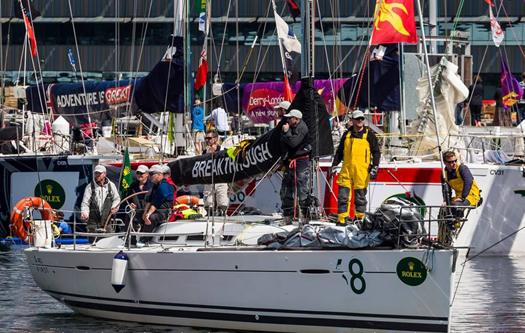
Breakthrough arrives in Hobart. Photo: Carlo Borlenghi/Rolex
Top Irish Offshore Sailors Eye 70th Sydney–Hobart Yacht Race Prize
#sydneyhobart – Ireland's Barry Hurley, who was part of a winning crew in last month's Middle Sea Race is heading next for The Cruising Yacht Club of Australia's 2014 Rolex Sydney Hobart Yacht Race. The 70th edition is bringing new, old, large and small together for the start on St. Stephen's Day.
Due to the large number and sheer size of some yachts, there will be three start lines this year. The last time numbers topped 100 was in 2004, when 116 boats started, though just 59 finished, the rest unable to withstand the punishing weather of the 60th race.
Sailing with Hurley, who was first in class one in IRC and ORC in the Med, will be INSS's Kenny Rumball along with some other Irish offshore crews on an Australian entry.
Five super maxis, 10 international entries, previous overall and line honours winners, old timers, record breaking boats and people - and the faithful.
One cannot go past two-time treble crown winner and reigning record holder and line honours champion, Wild Oats XI owned by Bob Oatley and skippered by Mark Richards, for line honours. In 2013 they won a protracted battle with Anthony Bell's Perpetual Loyal (former Rambler), allegedly the fastest super maxi in the world.
The two are constantly evolving, undergoing further modifications during the year. Their owners have recruited crews strewn with yachting identities and they will need everything they can muster to take on the other 100 footers in the frame.
Syd Fischer's new Ragamuffin 100. The modified deck of his previous yacht (it took line honours in 2011 under Anthony Bell's ownership) has received a new water ballasted hull. A canting keel completes the picture. Fischer, 87, will tick off his 46th Hobart this year.
Jim and Kristy Hinze Clark's new Comanche (USA) illustrates the latest technology and is the most talked about boat in the fleet. A second American entry is RIO 100 (previously Lahana). Purchased by Manouch Moshayedi, he has lengthened her to 100 feet.
Mini Maxi Yacht Loki with Irish Connections is Up for Sale
#boatsforsale– The mini Maxi Loki in which Dublin Sailor Gordon Maguire won the 2011 Rolex Sydney-Hobart Race, a high point in his career as a leading international professional sailor based in Australia, is now for sale.
Loki is a high performance racing yacht that has been professionally maintained and has a proven offshore and inshore track record. The advert for Loki is attached below.
The offshore pedigree of this yacht is second to none and offers a turn-key solution that will allow her new owner to compete to a high level in
both inshore and offshore regattas anywhere in the world.
The recent significant drop in the Australian Dollar makes Loki even more attractive especially when yacht designers Reichel Pugh say they have a motivated seller and all offers are to be considered.
No expense was spared in the build and upkeep of LOKI. Certainly one can build a new Mini Maxi design at a cost of three times LOKI's sale price and still not be guaranteed to win the next Sydney-Hobart, Bermuda Race or Fastnet, something that LOKI is well capable of, say Reichel Pugh.
Outfitted with a superb rig, sails and hardware, all LOKI needs is a new owner and team who want to Win Blue Water Classics or Inshore Races. Round Ireland anyone?
#rshyr – Royal St George Yacht Club offshore sailor Jerry Collins is no stranger to offshore racing having participated in four Fastnet races, two of which were on Sigma 38, Persistance. The Dubliner has also completed five Round Ireland Races, and is a three times Class winner in the Sigma Class on Persistance in 2008, 2010 and 2012 so it was easy to see why – having retired from the race in 2012 – the call of Australia's Sydney-Hobart race was hard to refuse this Christmas. Here Collin's describes the race onboard the Farr 40 Primitive Cool
In 2012 our RI bowman was Australian Matt Fahey (whose father is former Prime Minister of New South Wales and presently Chairman of the International Drugs in Sport Monitoring Body). Matt's grandparents were from Galway. Matt then invited me to do the 2012 Sydney Hobart on a Farr 40 which he was skippering/managing in Melbourne for the owner, John Newbold.
I did the Sydney Hobart in 2012 on the Farr 40, named Primitive Cool, as helm and navigator.
Three days into the race, having led our class by 14 miles at one stage, we suffered significant rig damage and were obliged to retire from the race and motor sail back to Eden , lest we lose the mast and rig and as the owner John Newbold was not on board, retiring was deemed the prudent, if unpalatable decision to make.
By the time 2013 rolled around it was decided to do the race again...we just had to finish what we had started !
Just 2 months before the race start on Stephens Day, John Newbold made the very bold decision to replace the Farr 40 with the new 'Primitive Cool', namely the old 'Secret Mens Business', a Reichal Pugh 51.
So, Primitive Cool, now with a crew of 15, 11 Aussies, 2 Brits, 1 Norwegian and 1 Paddy (myself), started the race with the primary objective of finishing the race this time, in view of last year's retirement.
It was clear in the first few hours, even in 5-10 knots of breeze that we would be competitive in our class and perhaps even overall. The first 24 hours was more or less a beat in 5-10/15 knots. The second day was mostly a reach in increasing wind strengths of up to 25 plus knots.( They say in Australia that they do not take down spinnakers until God actually takes them down and then they just put up a smaller one!)
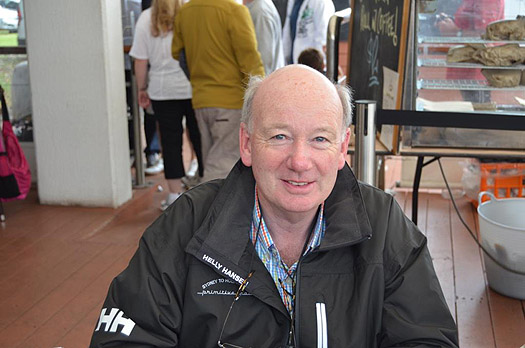
Jerry Collins in Hobart
The last (3rd day) 24 hours was very much a beat in gale/storm force winds averaging 37/38 knots and gusting up to 58 knots. These conditions did not come as a surprise to us as they had been predicted very accurately by the Australian BOM (Bureau of Meteorology )in the days before the race start, to come in from S/SW as we beat down the Tasmanian coast.
In view of the horrendous conditions prevailing over the last 12 hours, Primitive Cool sailed in the lee of Tasmania to seek some degree of shelter. At the end of the day this however cost us 2/3 hours at a crucial time which may have prevented us from attaining a podium place by a relatively small margin, after 3 days plus of hard boot to the floor racing.
Ultimately Primitive Cool finished 4th on IRC in Class 1 (21 boats in class) and 15th overall ( 94 boats starting)...a great result in all the circumstances particularly when we were competing against mostly much much larger, faster boats crewed for the most part by full professional crews.
Now, if only we could transport Primitive Cool to Wicklow for the Round Ireland next June!
Victoire for Dr Darryl in a Hobart Classic
#rshyr – Around Sydney and the clubhouse of the Cruising Yacht Club of Australia, he's Dr Darryl, the living breathing embodiment of modern Australia writes WM Nixon. In a country moving on very rapidly from rough blokedom to smooth hyper-affluence, this man is the new world. Even when still a bit wind-blown and battered on the Derwent quayside after a rugged Sydney-Hobart Race, he still looks as though he has been sent out by Central Casting to play the role of a thoughtful plastic surgeon, which just happens to have been the career choice of Dr Darryl Hodginson.
Having made a success of that, he chose to go offshore racing. And he did so to such good effect that in 2011 he was Rookie of the Year. Then in 2012 he was Australia's Offshore Racer of the Year. There's only one peak to climb after that, so for 2013 he went for it. He sold his consistent First 45, and bought Chris Bull's Cookson 50 Jazz with the express purpose of winning the Rolex Sydney-Hobart Race within two years.
He bought the boat as a 65th birthday present for himself, telling his wife that it was nor or never for a Hobart win. Re-named Victoire, this beautifully-maintained example of what is indubitably one of the greatest all-round designs of contemporary offshore racing has come up trumps for him at the first shot, winning the famous Tattersall's Cup overall. On IRC, her corrected time of 3 days 18 hours 27 minutes and 43 seconds is a very convincing hour and five minutes ahead of the next best, Phil Simpendorfer's Elliott 44 Veloce.
Victoire is sailed by a crew of mates. "We don't fly in a lot of expensive people" says the Doctor. Key man after the owner-skipper is Sean Kirkjian, ace helm and tactician, and between the determined and visionary owner and the skilled all-round sailor, they trained their crew of weekend sailors into a formidable group who raced this demanding but rewarding boat to success.
Another success of the 2013 Rolex Sydney Harbour Race has surely been the IRC. Beforehand, it seemed a little odd that the vintage Wild Oats XI rated quite a bit higher on IRC than the other top hundred footer, Anthony Bell's Perpetual LOYAL. But although Perpetual showed her dazzling potential with speed bursts of 35 knots once the gale arrived, overall in what were genuinely average summer conditions, the overall performance abilities of Wild Oats were reflected by her IRC number, whereas Perpetual doesn't really sail up to her rating until winds get above 12 to 14 knots.
In any Hobart Race, just as in the Fastnet, boats of a particular size, or rather comparable boats of a similar rating, will tend to be favoured by the actual pattern of conditions experienced. This is demonstrated very forcefully in the Hobart results. Of the first six boats overall, five fall within the 1.250 to 1.381 rating band. The exception is Bruce Taylor's Reichel Pugh-designed Caprice 40 Chutzpah, which took fifth overall on a rating of 1.197, which puts her broadly in the same area, in which Victoire is at the top end with an attractively competitive rating of 1.350.
As for the Irish competitors, with Sean McCarter and Conor O'Byrne's runaway win with Derry-Londonderry-Doire in the Clipper fleet (it was four hours before the next boat finally finished), we've more than enough to b celebrating, but the Royal Irish crew led by Barry Hurley in the First 40 Breakthrough had a good showing to place 6th in Division 3 and 27th overall, putting them comfortably into the top third of the fleet.
The two very new girls on the block, Karl Kwok's 80ft Beau Geste and Matt Allen's 60ft Ichi Ban, will have some thinking to do. The fascination here is that each has been designed by former partners in the now defunct Botin Carkeek design team, with Marcelino Botin creating Beau Geste, while Shaun Carkeek mastered Ichi Ban.
This boat had to follow the all-conquering 63ft Loki, former mount of top helmsman Gordon Maguire. To this casual observer, Ichi Ban looks rather voluminous by comparison with the lean and swift Loki, and positively bulbous by comparison with Wild Oat XI, which carries all the excess flesh of a tinker's greyhound. Could it be that the new Ichi Ban has too much freeboard, too much hull buoyancy? You could understand why Gordon Maguire might be inclined that way, as he was at the helm of the Lawrie Smith-captained maxi Rothmans when she took a spectacular and much-publicised nosedive during a Sydney-Hobart, submarining for quite a long way. And then too, he was at the helm of Lough Derg YC's Jocelyn Waller's BH 41 Silk in Cowes Week when she deep-sixed in the Solent running before a squall above gale force. Nevertheless, you could be forgiven for wondering if all that buoyant hull up forward night be veering on too much of a good thing on Ichi Ban.
Dun Laoghaire Crew Finish Sydney-Hobart Sixth in Div Three
#rshyr – The Dun Laoghaire crew led by Barry Hurley of the Royal Irish Yacht Club have successfully completed a testing Sydney–Hobart race to finish 27th overall in the 92–boat fleet and take sixth place in IRC Division 3 in First 40, Breakthrough. Official standings here.
Racing since St. Stephen's Day the Irish crew consisted of Barry Hurley (Skipper), Kenneth Rumball (Watch Leader), Keith Kiernan (Navigator & Radio man), Catherine Halpin (Bow-Woman).
The crew finished in the early hours of yesterday morning in Tasmania with an elapsed time of 4 days, 2 hours and 21 minutes.
Day 5 and the remaining boats racing in the Rolex Sydney Hobart Race had a slight respite from prevailing weather conditions as the southwesterly moderated to 20 - 25 knots over night into this morning (December 30).
Unfortunately for Roger Hickman's Wild Rose, any chance of upsetting Victoire as overall handicap leader went by the boards with the diminishing breeze - at 4am AEDT when the boat needed to finish, it still had 35 miles to go.
By mid-morning the Cruising Yacht Club of Australia could confirm that Darryl Hodgkinson's Cookson 50, Victoire was the official Overall Winner of the 69th edition of the Rolex Sydney Hobart Yacht Race. At a dockside presentation, Hodgkinson the owner/skipper, was presented with the Tattersall's Cup and a Rolex timepiece.
Hodgkinson, a plastic surgeon from Sydney, bought the boat as a birthday present to himself and told his wife his goal was a two-year plan to win the Rolex Sydney Hobart Race -- he fast tracked the timeline, succeeding on his first try. This was Hodgkinson's third go at the race, having competed in 2010 and 2011 on his Beneteau 45.
Elated with the win, Hodgkinson said, "This is the culmination of a great campaign, it's a personal victory and one I share with all sailors who did the race. I feel somewhat humbled to have won."
The exuberant skipper was quick to praise his mostly amateur crew and put the win down to meticulous planning and preparation. He praised tactician and strategist Sean Kirkjian – a 17-time race veteran – and said, "He's a wizard, who is just playing 'ocean chess' all the time". As well he touted Danny McConville, who has prepared two or three Hobart winners before, and said "This boat was in marvelous condition before we left the dock. We had a fair bit of preparation, I'd say."
Victoire's navigator, Phil Eadie confirmed the meticulous preparation and 'leaving no stone unturned' approach and said, "A lot of work has gone into this with Darryl. He had meetings every morning for months, making sure everything works.
Eadie has sailed in 34 editions of the race, and used that experience to draw from, "I plotted the tracks of a lot of the ones we've won before or other people have won before, just to sort of get a feel of it – that we didn't step too far outside of the paddock.
"There was a lot of preplanning, mostly in the last 24 hours before the start – we planned the whole race what we would do in theory, based on the weather, and had that laid out – and balanced that against reality. We have a really good weather guy, Chris Buckley from Perth, and he gave us a lot of good input."
Hodgkinson recalled the key elements of Victoire's win, "It was a fairly tough race. When we got that heavy northeasterly, there were moments when we had to believe in ourselves, and our yacht. We knew this boat had won before, and so we let it run. We knew we were only going to win if we pressed really hard, and we couldn't let our foot off the pedal. And there were some moments when the foot was right down and it was like 'oh, this is a ride', and we were thrilled. Of course it was part terror! At one point, we had a Chinese gybe – which was pretty scary – but amazingly we got the boat up and going, and it worked out.
"But we changed our sail plan after that, and were quite surprised with the change from the A4 (headsail) to A6, how we could still maintain the speed. So I think we learned on the stick, as it were, on that one."
A steady stream of yachts crossed the line over the past 24 hours, and as of 6pm local time AEDT, there were 17 yachts still racing, 67 finishers, and 10 retired. The back marker was the 38-footer, Déjà Vu, which was expected at the finish early on the morning of January 1st.
Irish Yacht Derry–Londonderry Takes Sydney–Hobart Clipper Win
#rshyr – A dream came true for Lough Swilly skipper Sean McCarter (31) at 1916 hrs this evening (Sunday December 29th) when he skippered the Irish Clipper 70 Derry-Londonderry-Doire across the elusive finish line at Hobart in Tasmania to win his class in the 628-mile Rolex Sydney Hobart Race writes W M Nixon
Although the Derry boat and Sean's crew (in which Garda Conor O'Byrne of Balrothery, Co Dublin is a Watchleader) had a lead of 17 miles over the next boat at the finish, the final stages up the Derwent Estuary to the line of the Hobart waterfront as the dawn came up were tense in the extreme. Their speed fluctuated between 2 and 8 knots in the flukey night winds, and they'd nightmares of becoming totally becalmed and then watching the opposition close up with the morning breeze.
To get there in 3 days 16 hours and 42 minutes from Sydney, the crew (of all levels of sailing experience including none at all) had to cope with everything ranging from the hectic start down Sydney Harbour, through frustrating light winds off Australia's southeast coast, and then a rising southwest to west gale as they battered their way across the notorious Bass Strait towards the final hundred miles along the Tasmanian coast and the challenging and wayward approaches to Hobart.
As the gale built, DLDD was neck and neck with Henri Lloyd, until then the boat which had been setting most of the pace in the Clipper series. But a rudder bearing problem aboard HL east of Cape Barren Island led to her eventual retiral from this leg, and Derry Londonderry Doire was left on her own to make the pace, with about ten miles in hand on the next group of boats.
It was a game of cat and mouse, and at one stage they'd opened out the gap to 14 miles, but at other times the tricky headlands and islands of Tasmania saw the pace slacken and the boats astern close up.
For a while nearing the Storm Bay approaches to the Derwent, it looked as if DLDD had it made, as they opened out their lead to nearly twenty miles. But the final miles in the dark were very tricky, "a real nail biter" as McCarter reported - from time to time they seemed to be virtually stopped ,while the boats still out at sea were making full speed. But onward they crawled towards the line, and at 05:42:28 am local time, they were there, the win in the bag, the race sailed in three days 16 hours 42 minutes and 28 seconds, an average of 7.1 knots. And to add a bit of cream on the cake, this remarkable performance has placed them 7th in Division 1 IRC, competing against some of the hottest boats in the fleet.



























